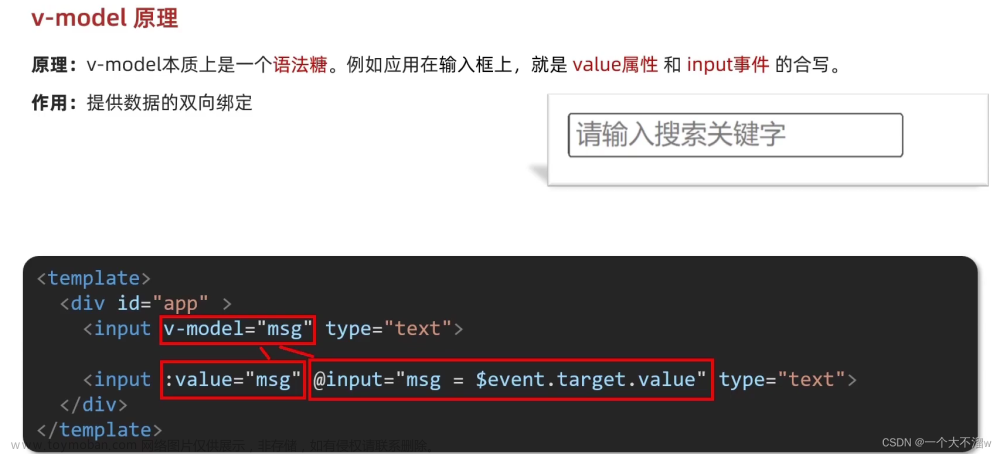在vue中数据的流向通常是单向的,但是实际开发中,存在子组件对父组件值进行更新的情况,例如对表单组件进行二次封装等,父组件需要响应子组件的变化。双向绑定呼之欲出,vue提供了两种方法进行双向绑定:
1、使用v-model指令
在父组件上 v-model 会利用子组件名为 value 的 prop 和名为 input 的事件,父组件上的值的变化通过 value 传递到子组件,子组件的变化通过 emit 触发 input 事件传递回去。
<template>
<div id="app">
<the-input v-model="name"></the-input>
<div>这是你的名字:{{ name }}</div>
</div>
</template>
<script>
import TheInput from './components/TheInput'
export default {
components: {
TheInput
},
data() {
return {
name: ''
}
},
};
</script>
子组件代码如下:
<template>
<input v-model="name" type="text">
</template>
<script>
export default {
name: 'TheInput',
props: {
value: {
require: true
}
},
computed: {
name: {
get: function () {
return this.value;
},
set: function (value) {
this.$emit('input', value)
}
},
}
}
</script>
v-model 初衷是服务于表单元素,非表单元素在使用时,可以修改子组件的 model 属性的 prop 及 event,实现自定义 v-model 绑定的属性名和触发事件名。
<template>
<input v-model="name" type="text">
</template>
<script>
export default {
name: 'TheInput',
model: {
prop: 'pName', // 默认值为value
event: 'change' // 默认值为input
},
props: {
pName: {
require: true
}
},
computed: {
name: {
get: function () {
return this.pName;
},
set: function (value) {
this.$emit('change', value)
}
},
}
}
</script>
2、使用.sync修饰符
除了 v-model 之外,vue 在数据绑定时提供了 .sync 修饰符,可以对需要双向绑定的属性进行标记,在子组件中可以通过 update:propName 事件子组件的值同步至父组件。
<template>
<div id="app">
<the-input :pName.sync="name"></the-input>
<div>这是你的名字:{{ name }}</div>
</div>
</template>
<script>
import TheInput from './components/TheInput'
export default {
components: {
TheInput
},
data() {
return {
name: ''
}
}
};
</script>
子组件:
<template>
<input v-model="name" type="text">
</template>
<script>
export default {
name: 'TheInput',
props: {
pName: {
require: true
}
},
computed: {
name: {
get: function () {
return this.pName;
},
set: function (value) {
this.$emit('update:pName', value)
}
},
}
}
</script>
注:v-model 可以理解为 .sync 的语法糖
3、单向数据绑定实现
由于双向绑定存在不确定性,所以在使用的时候要格外小心,切记不可滥用双向绑定。那么在不使用官方提供的双向绑定,是不是就其他方案实现这种效果了?答案是有的,在单向数据流的基础上,只要在子组件修改了父组件值,就能达到双向绑定的效果。
这里总结三种方法:文章来源:https://www.toymoban.com/news/detail-463485.html
- 使用 $parent 获取父组件实例,直接修改父组件实例上的数据
- 通过 prop 向子组件传递一个可以修改父组件值的方法,子组件调用方法修改
- 在子组件上添加自定义事件,通过 emit 触发更新
注:不要和前面双向绑定的 emit 混淆,这里 emit 所触发的自定义事件需要显示定义,这样看来 vue 中的双向绑定更像是语法糖文章来源地址https://www.toymoban.com/news/detail-463485.html
到了这里,关于Vue父子组件间数据的双向绑定的文章就介绍完了。如果您还想了解更多内容,请在右上角搜索TOY模板网以前的文章或继续浏览下面的相关文章,希望大家以后多多支持TOY模板网!










